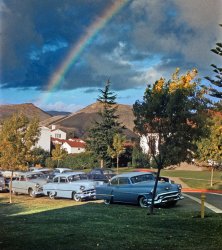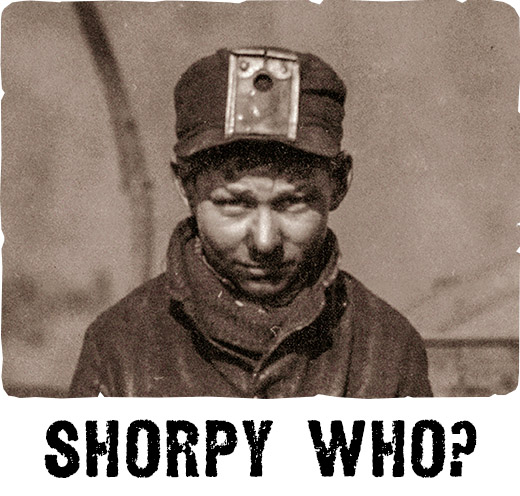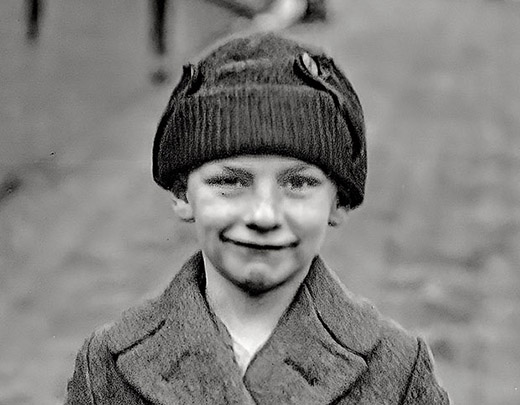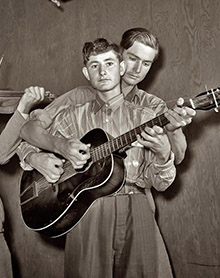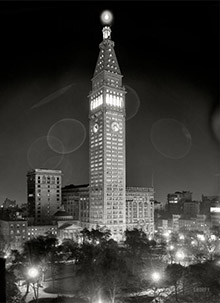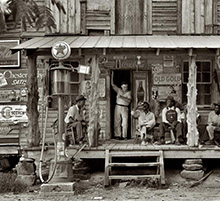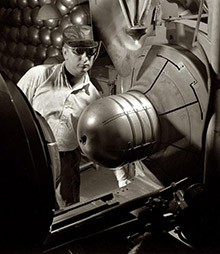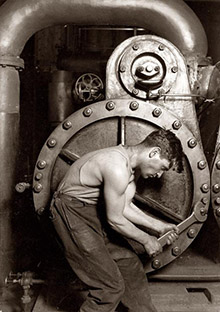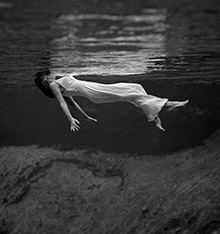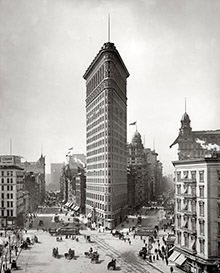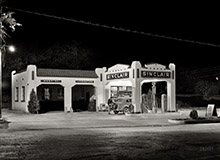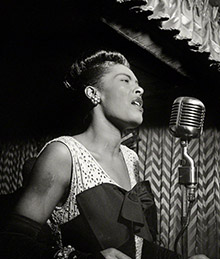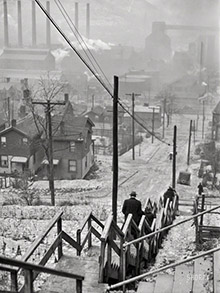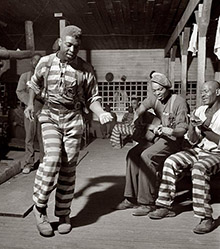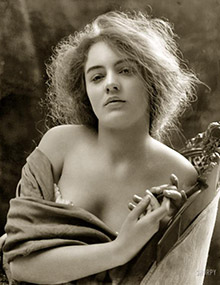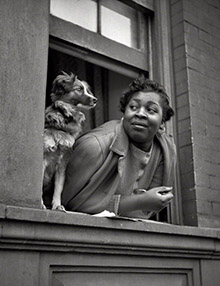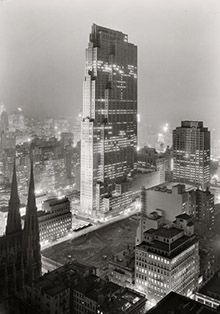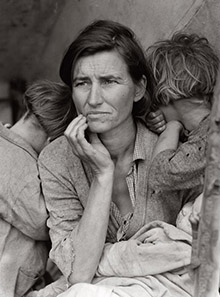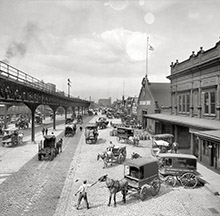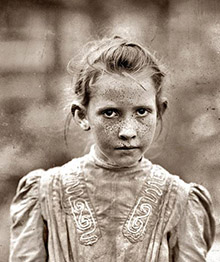
MAY CONTAIN NUTS

Search Shorpy
SHORPY ART
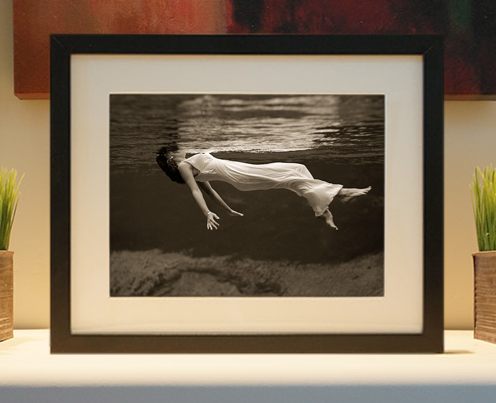
Framed or unframed, desk size to sofa size, printed by us in Arizona and Alabama since 2007. Explore now.
Join and Share
Ad-Free Shorpy
Shorpy is funded by you. Patreon contributors get an ad-free experience.
Learn more.

Recent comments
- Lofty addition
- In 1912
- Keenan Building
- Six years old
- Taken from the P.J. McArdle Roadway?
- It stood only 47 years
- Three track mind
- Incline to the right
- Reach for the sky, 1912 style
- No clean sweep
- Same Job Title, Same Face
- Sadly Lost
- Beautiful ...
- Where you get your kicks
- Aim High
- Pueblo Revival sisters
- Pueblo Neoclassicism
- Milk Man
- Regional dialect.
- Spielberg's inspiration
- Great Photo
- Loaf Story
- Do you still have the Rakes category?
- Could almost be a scene from the 1957 movie 'Hell Drivers'
- The Wages of Fear.
- Conspicuous by their absence
- Got Milk?
- All that aluminum
- No lefties
- Smoke 'em if you've got 'em
Member Photos
The Shorpy
Print Emporium
Print Emporium
Search Shorpy
Search results -- 30 results per page
- Smoke on the Water: 1905
- ... Publishing glass negative. View full size.
Cattle cars Looks like the Detroit was carrying a load of livestock cars. I wonder it they were full or empty. Looking at car #3818 I would say ... Posted by Dave - 08/02/2012 - 7:42pm -
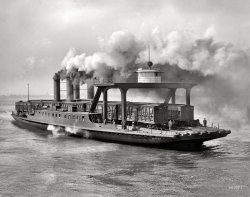
- Hudson Motor Cars: 1911
- Washington, D.C., circa 1911. "Hudson cars, H.B. Leary agency, 1317½ 14th Street N.W." Harris & Ewing Collection glass negative. View full size.
Keep the Cars Coming! I love the pictures of the cars! Where else can we see such detail of these cars "in period"?
Enough! ... Posted by Dave - 08/07/2012 - 10:39pm -
![Hudson Motor Cars: 1911 Washington, D.C., circa 1911. "Hudson cars, H.B. Leary agency, 1317½ 14th Street N.W." Harris & Ewing Collection glass negative. View full size.
Keep the Cars Coming!I love the pictures of the cars! Where else can we see such detail of these cars "in period"?
Enough!How many more pictures of DC car dealerships are we going to have to suffer through?
Squeeze me.I bet kids found those horns irresistible as they walked by parked cars.
Great Scott!I looked and looked, and then my wife noticed: These are all right hand drive cars! Why???
99 years and still on the roadHere's a 1911 Hudson, snapped at a car show in Concord, North Carolina, April 10th, 2010. Its body style (touring car) is like the one visible in the storefront window. This was only the third year for Hudson production.
No Hupmobiles?Five spiffy Hudson models in a row and not one Hupmobile! I owned a Hudson myself for over 40 years. They were good cars (obviously).
Great historical car photographI love these vintage car photos. They are as much about our history as the architecture behind them. This photo just got copied into the Hudson folder in my digital car collection.
memo to 8:28Hey Anon at 8:28 - some of LOVE pictures of old cars.
If you're "suffering" - GO SOMEWHERE ELSE !!!!!!
What's wrong with cars?What's wrong with pictures of cars? Besides, they're neighborhood pictures. At least around here, we no longer have laundries on the scale of the Star Laundry next door. Quaker Oats isn't a surprise, but some of the store-side ads are. Some products are a lot older than you think.
Please keep to the LeftThere was no requirement for left-hand steering in those days-- but Henry Ford switched from right to left in October 1908 as his Model S gave way to the Model T, and he wound up with enough sales volume to influence the trend. By about 1914, most or all the US cars had settled on left-hand drive.
[In 1914, many if not most American cars used right-hand drive. Even in the early 1920s some manufacturers were still using RHD. - Dave]
Seriously?These dealership photos are beautiful. Americana at its finest. Keep 'em comin'.
Anyone know where Star Laundry might be?I see eight signs in this picture. Wow.
Star LaundryThe Star Laundry building is still there, relatively uncannibalized, at least above the first floor level. At street level, it is now the La Villa Restaurant, a take-out fajitas and taco joint. The buildings on either side, including the Hudson dealership, have been "updated" beyond recognition. No way to tell if the buildings behind the faux siding are even the same as what was there in 1911. The Star building is holding up well though.
View Larger Map
My HeritageAs the scion of two generations of hand laundrymen, I understand the importance of "We mend your linen." If the customer didn't know his sheets were torn, the storekeeper took the heat. Sometimes they would be beyond repair and were returned unlaundered.
As for "Regular Pkgs 10¢" -- my grandfather opened his laundry on Market Street, on the Lower East Side, in 1910. Unfortunately, he died in 1935, so I'll probably never know if he ever got as much as a dime for a bundle of wet wash.
In any case, notwithstanding the disapproval of Automobile Dealership Americana, this is one great photo.
Left and RightEarly cars had right-hand steering because the brake lever (which was hand-operated), gearshift and horn were on the outside of the car. Since most drivers were right-handed, they had to sit on the right to reach them.
Car displayWhat I find so interesting about most of these car photos is that the cars are displayed on the street. The businesses were storefronts rather than stand-alone car lots. I suspect this is the case since cars were rare and most probably had to be special ordered. I wonder when the stand-alone lots became the standard mode of car sales.
Bring on the Detroit DealershipsI can't wait until you feature MORE early car dealerships. Bring 'em on!
8:28: What a Party PooperI love the old auto dealership photos. Why should 8:28 complain? There are also old buildings in the photo.
I propose that a right-hand drive auto be driven over the foot of 8:28 until a more reasonable attitude is evinced.
More HeritageMy dad was an automobile dealer all his life. I practically grew up in showrooms and used-car lots in the 1950s and 1960s. I love these shots, keep 'em coming!
Times have changedThat Hudson dealership is now a gay bathhouse.
(The Gallery, Cars, Trucks, Buses, D.C., Harris + Ewing)](https://www.shorpy.com/files/images/20473a.thumbnail.jpg)
- Kimo Kiva Blatz: 1943
- ... relegated to a computer in a closet somewhere.
Kimo Cars Can someone ID them?
[1936 DeSoto Airstream, 1939 Chevrolet ... Posted by Dave - 07/03/2024 - 5:38pm -
![Kimo Kiva Blatz: 1943 February 1943. Albuquerque, New Mexico. "Photographs show the modern city and 'Old Town' Albuquerque." Now playing at the "Pueblo Deco" Kimo on Route 66: Hitchcock's "Shadow of a Doubt." Acetate negative by John Collier for the Office of War Information. View full size.
Now Showing ...Good to see it's still there!
+72Below is the same view from July of 2015.
Pane managementVery few are aware what "new and efficient" windows do to old buildings. Like gouging out someone's eyes and replacing them with whatnots. At least try to emulate the original windows pane modules. But of course: "Money, you know".
"Kimo" cannot be rightI first thought seeing this, thinking "Kino" obviously more appropriate for a cinema, but was I wrong. The Albuquerque Journal in 1927 launched a contest to name the theatre provided the entries were an "Indian word" no more than six letters in length. The winning submission was Kimo, "mountain lion" or "king of beasts" in the Tewa language of the native Pueblo.
Air CheckKGGM radio (the neon sign by the window to the left), if it exists at all today, is likely relegated to a computer in a closet somewhere.
Kimo CarsCan someone ID them?
[1936 DeSoto Airstream, 1939 Chevrolet (van?). - Dave]
She left no doubtIt's a shame there was no room on the marquee for Patricia Collinge, who was outstanding as one Charlie's sister and another Charlie's mother in Shadow of a Doubt. Excellent movie. She was equally compelling in another film a few years earlier: The Little Foxes, also starring Teresa Wright, along with Bette Davis and other luminaries of the screen.
Room for Patricia CollingeI could not manage to find the original movie posters shown in the picture. The ones I could find were different, but ... with (though little) room for Patricia Collinge.
(The Gallery, John Collier, Movies)](https://www.shorpy.com/files/images/SHORPY-8d14820u.thumbnail.jpg)
- Lots of Pulp: 1890s
- ... can't look stylish working in a paper mill?
Furniture cars Both this and the recent Buffalo picture show rail cars dedicated to furniture transport. As far as I know those types of cars ... Posted by Dave - 07/26/2012 - 4:56pm -
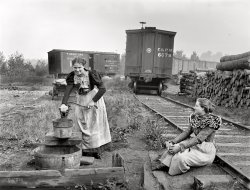
- Crippled Children's Auto Outing: 1908
- ... owned this building in NYC.
Crazy looking ladies in cars All of that is true but how nice these people were, taking these kids ... provide some more 'crazy photos' !
crazy looking cars...
please observe the roads. abosolutely a paradise for joy riders. ... Posted by Dave - 09/08/2011 - 11:54am -
![Crippled Children's Auto Outing: 1908 "Auto Rides for Crippled Children," New York. May 25, 1908. 5x7 glass negative, George Grantham Bain Collection. View full size | Zoom in.
Is That?Is that someone in the window on the left of the stoop where the women are standing? Notice the 2 fingers on the window sill and the face peering through the curtains. Very creepy!
Above The First Doorway......on the left I see what appears to be the name "Blackburn" which is my last name. Now it's going to drive me nuts trying to figure out if some relative of mine had once owned this building in NYC.
Crazy looking ladies in carsAll of that is true but how nice these people were, taking these kids out maybe to the circus, beach or somewhere. You don't often see pictures of the upper class doing something nice. But they are pretty crazy looking.
Crippled children'sIt is an amazing experience to watch this rare photo.
Please provide some more 'crazy photos' !
crazy looking cars...
please observe the roads. abosolutely a paradise for joy riders. But unfortunately now we have excellent cars. But where are the- car friendly roads !
White MasksWhy do the women have the white masks on? to keep the sun off? I've never seen any other pictures from this time having such masks.
Re: White MasksThat's netting to keep the dust out of their eyes. Part of any fashionable lady's motoring ensemble back then.
Because bugs in your teeth......is not only UNfashionable, it's downright disgusting. Thank goodness for enclosed passenger cabins and convertible windshields.
:-)
All of the cars seem to beAll of the cars seem to be the same make and model and they all have their steering wheels on the left side.
Not sure when the left side became the standard in the states.
[Steering wheels on these cars are on the right. - Dave]
Thomas FlyerThese cars bear a strong resemblance to a Thomas Flyer of the period. For many years, "quality" cars always had their steering wheels on the right-hand side, regardless of whether the country they were built in drove on the left or the right.
(The Gallery, Cars, Trucks, Buses, G.G. Bain, Kids, NYC)](https://www.shorpy.com/files/images/00497u_0.thumbnail.jpg)
- Easter Sunday, 1936
- ... by Theodor Jung for the Resettlement Administration.
Cars Can anyone perhaps identify the cars?
The cars (subject to correction) Right to left: Ford V8, Chrysler, Lincoln
... Posted by Dave - 12/09/2007 - 11:10pm -
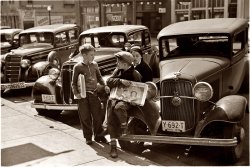
- Hotel Franciscan: 1943
- ... It would make a heck of a resort hotel.
(The Gallery, Cars, Trucks, Buses, John Collier) ... Posted by Dave - 07/20/2024 - 3:22pm -

- Yard Jockey: 1943
- ... wipers. - Dave]
(The Gallery, Baltimore, Cars, Trucks, Buses, Handsome Rakes, John Vachon) ... Posted by Dave - 07/18/2024 - 7:39pm -
![Yard Jockey: 1943 March 1943. "Baltimore, Maryland. Associated Transport Company trucking terminal. 'Yard jockeys' or 'spotters' drive trucks around the terminal and back them up to the loading platform." Acetate negative by John Vachon for the Office of War Information. View full size.
Could almost be a scene from the 1957 movie 'Hell Drivers'Obviously it isn't!
Do you still have the Rakes category?I think he qualifies.
Great PhotoHow does one get such dramatic lighting AND no reflections from the windshield?
[The light is inside the cab. - Dave]
Spielberg's inspirationSo that's what the truck driver in Duel looked like!
Regional dialect.Every region had their own terms. When I drove trucks we called them "yard horses" or "hustlers". The tractors they drove were special models which can pick up and drop trailers quickly without having to wind up and wind down the landing gear.
Same Job Title, Same FaceThat's my job for nearly 15 years now, and whatever the man in the picture is feeling, my expression is often similar, just another day of hooking and unhooking, opening and closing trailer doors. Nowadays we have the convenience of a sliding rear door, which this truck does not appear to have. As previously mentioned, a hydraulic fifth wheel, as well as air operated release are convenient, too.
No clean sweepAny drivers recognize the hand (!) operated windshield wiper (singular)?
I can't imagine driving in a storm using that.
[The truck has two power-operated wipers. - Dave]
(The Gallery, Baltimore, Cars, Trucks, Buses, Handsome Rakes, John Vachon)](https://www.shorpy.com/files/images/SHORPY-8d14511u.thumbnail.jpg)
- Mack Attack: 1943
- ... trucks had them a bit before that.
["Blinkers" for cars got their start in the late 1930s. - Dave]
About that twin stick ... is to drive really fast.
(The Gallery, Baltimore, Cars, Trucks, Buses, John Vachon) ... Posted by Dave - 07/11/2024 - 11:02am -
![Mack Attack: 1943 March 1943. "Baltimore, Maryland. Associated Transport trucking terminal. Truck loaded with explosives." Acetate negative by John Vachon for the Office of War Information. View full size.
At LargeThe previous radiator cap(s) must be on the loose. This one is leashed.
The cabs on those old trucks were so narrow.How narrow were they? They were so narrow you could get both arms sunburned at the same time and in this case the driver's countenance would be affected after enough miles rolled by looking up a bulldog's butt.
"Built Like a Mack Truck"Thanks for sharing images of various hard-working trucks from WWII. These had no power steering, no air conditioning, no air ride suspension, sometimes had twin stick transmissions. If you're not familiar with that, take a look at YouTube. This "bulldog tough" specimen has a modest electric horn on the passenger's side of the cab accompanied by a couple of fearsome air horns up on the roof.
Explosives and trucksOn the way to Hawthorne, Nevada, site of an Army depot, we noticed this sign outside the town of Luning: “No Parking Explosives Laden Trucks Within City Limits”. If you have such a truck, you may be very limited where you can park.
War PlanningExplosives haulers get the new tires.
Red for DangerNote the flags. Probably red, for the explosives. Unlike the white flags on so many Shorpy locomotives. I'm guessing the "Explosives" sign was red, too.
The truck seems to be getting a little shuteye, or is it winking at the camera? If wartime precaution, why not on both headlights?
[Because when your headlight burns out, you replace it with whatever is handy? - Dave]
Turn signalsWhat else could that arrow on the fender be for? I remember a character in a John Updike short story from the early 1950s bragging that his new car had blinkers, like it was a prestige thing. I guess heavy trucks had them a bit before that.
["Blinkers" for cars got their start in the late 1930s. - Dave]
About that twin stick transmission ...It was a 2 stick 6 speed. Basically a 5 speed with the option of an extra low first gear. An "underdrive" if you will.
The main box has 5 forward gears.
The aux has reverse, low, and direct.
Wages of FearTolar New Mexico was basically wiped off the map in 1944 after a train carrying 160 500-pound bombs (enough to fill four B-29 bombers) caught fire and exploded after stopping there.
The Wages of Fear. The secret is to drive really fast.
(The Gallery, Baltimore, Cars, Trucks, Buses, John Vachon)](https://www.shorpy.com/files/images/SHORPY-8d14551u.thumbnail.jpg)
- Lukens Lake: 1956
- ... a couple of '50/51 Fords, a Buick and a Pontiac)
The Cars Good job everyone. From left to right are: 1950 Ford, 1950 Buick ... 1955 Chevrolet wagon, with different taillights).
The cars I'm pretty sure that the first Ford is a '49. We had one when I was a ... Posted by Dave - 07/29/2012 - 7:59pm -
![Lukens Lake: 1956 "Bath house at Lukens Lake near Peru, Indiana. July 1956." 35mm Kodachrome transparency. View full size.
I'll Take a Shot At IDL to R: 49/50 Ford; 49/50-51 Buick, 49/50 Ford, don't know, a Muntz Jet maybe?, Pontiac Wagon, early 50s (used Chevy tail lights with chrome insert)
Car IDThe fourth car from the left seems to be a Kaiser or a Henry J, probably the latter which was also sold by Sears--think they called it the Allstate. The one on the right looks like a '56 Chevy wagon.
A near-forgotten model from American automobile history.The car with fuel stain by the gas cap (next to the Pontiac) is '51 (or so) Kaiser-Frazier Henry J. You can almost make out the script above the license plate.
49 FordThe car I learned to drive on was my dad's old blue 49 Ford with a column shift 3 speed. The body was absolutely cherry. My dad sold it for 50 bucks decades ago.
Car IDI see a Henry J! (and a couple of '50/51 Fords, a Buick and a Pontiac)
The CarsGood job everyone. From left to right are: 1950 Ford, 1950 Buick Roadmaster, 1951 Ford, Kaiser-Frazer "Henry J" (1951 model, most of which had no trunk lids), 1955 or 1956 Pontiac wagon (which both used the same rear fenders as the 1955 Chevrolet wagon, with different taillights).
The carsI'm pretty sure that the first Ford is a '49. We had one when I was a kid, and the trunk lock mechanism piece above the license plate was straight and did not turn down at each end like the one in the picture. The '50 Fords had the "turned down" piece.
The carsEditing my own reply. I meant to say the first Ford is a 1950 model since it has the turned-down trunk lock piece above the license plate.
[You are correct. Thanks for the info. Now, who can tell if the station wagon is a 1955 or 56 Pontiac? The red-and-white color scheme is shown in the 1956 sales brochure. - Dave]
Car conditionLook how quickly these autos lost their finish, all except the Pontiac wagon look much too rough for their six or seven years of use.
Pontiac WagonI vote for the Pontiac being a '55. I've got a print of my twin brother and I up on top of the family's '55 Pontiac wagon washing it (we were 8 years old, and not heavy enough to dent '50's sheet metal). What I can see of the back end in the photo, the taillights, rear trunk hinges, and bumper look identical. The photo though is mostly a side view so not all details are available. Our car had a two tone dark green, light green paint job.
Andrew Russell
San Diego
'51 Henry JThe Henry J is a '51. In 1952 the taillights went on to the fins.
[The other way you can tell it's a '51 is that there's no trunk lid. - Dave]
re 1955Here is a web adress,http://www.cars-on-line.com/stationwagon.html. You will see A 1955 pontiac chieftain wagon for sale. They have A pic of the rear and it looks the same as this one.
[The 1956 wagon would look the same in back. - Dave]
1955 GMThe Pontiac is a 1955, GM used the same basic design on Pontiacs and Chevys.
[Or it could be a '56. - Dave]
Re: 1955 GMIt could also be a 1956 Pontiac. The wagon rear ends were the same for 1955 and 1956.
Peru, IndianaBirthplace of one of the greatest songwriters who ever lived: Cole Porter!
Henry JSears Roebuck also sold the Henry J and called it the Allstate. The retail price was $999.
Kaiser-Frazer was an attempt at creating another brand in the automobile business after WWII, when cars were scarce. The biggest dealer was in California, a franchise owned by the promoter Earl "Madman" Muntz. His radio jingle was "The Kaiser-Frazer, yours at once, today at Madman Muntz."
After Kaiser-Frazer sank, Muntz just reached up on his shelf for his next idea. It was a low-price line of TVs, under $100, hawked on radio stations across the country. You called and got a visit from a salesman who carried the step-up model into your house and began his sales pitch. At his peak Muntz may have been the largest seller of TVs in the country.
PontiacThe Pontiac is a 1955. The 1956s had the name in script rather than in block letters. We had a 1956 sedan. My great-aunt had a Henry J just like this one, except that it was an ugly dark brown.
(The Gallery, Cars, Trucks, Buses, Kodachromes 1, Travel & Vacation)](https://www.shorpy.com/files/images/lukens56.thumbnail.jpg)
- Albuquerque: 1943
- ...
(The Gallery, Cars, Trucks, Buses, John Collier, Kids, Stores & Markets) ... Posted by Dave - 07/07/2024 - 12:36pm -

- Engine Overhaul: 1943
- ... to wait for parts sometimes.
(The Gallery, Baltimore, Cars, Trucks, Buses, Gas Stations, John Vachon) ... Posted by Dave - 07/10/2024 - 5:33pm -
![Engine Overhaul: 1943 March 1943. "Baltimore, Maryland. Associated Transport Company trucking terminal. Truck service shop." Photo by John Vachon for the Office of War Information. View full size.
One of the OriginalsAutocar is one of the oldest American vehicle manufacturers, tracing its origins to 1897. The brand is still in business today. The company has a long list of significant achievements, including building the first commercially available motor truck in the US in 1899.
Clean minds, filthy handsIn 1943 if someone told you they'd just performed a "head job", they'd likely feel no need to blush. (Wink wink). Associated was still relatively new when this pic was taken
Horton had started out in 1930 in North Carolina.
Flat headValve placement is the giveaway.
Ignorant questionJust looking at the pic, how do we tell whether the engine's a Diesel?
Oil soakedNice placement of the "SHORPY" logo
It's called a valve jobAnd materials and designs have improved such that engine overhauls and valve jobs are pretty much a thing of the past.
[I see a ring job underway. - Dave]
Too Many Baltimore PistonsI agree with Dave that it looks like a ring job. Note the left-foreground ring atop its waxed paper wrapping, on top of the stack of what looks like four new ring boxes.
There are four used pistons (with connecting rods) on the workbench, but not four piston-less cylinders in the open engine.
So to what engine do these four piston assemblies belong?
Just a head gasketI see no indication yet that this was a valve or ring job.
All that has been removed is the head. Pistons and valves are in place as are parts that would need removal to gain sufficient access to remove pistons or valves.
This may just be a decarboning operation or they may have had leakage of exhaust into the coolant.
Valve JobThere is a valve spring compressor on the last valve by the firewall. The pistons are probably from a different engine. It's not uncommon to have more than one job going at the same time. You got to wait for parts sometimes.
(The Gallery, Baltimore, Cars, Trucks, Buses, Gas Stations, John Vachon)](https://www.shorpy.com/files/images/SHORPY-8d14554u.thumbnail.jpg)
- Convo: 1943
- ... were built by the five manufacturers.
(The Gallery, Cars, Trucks, Buses, John Vachon) ... Posted by Dave - 07/09/2024 - 1:26pm -
![Convo: 1943 February 1943. "Truckers talking outside a diner on U.S. Highway 40 in Delaware." Acetate negative by John Vachon for the Office of War Information. View full size.
Truck IDLooks like a Corbitt.
Headed for the ferry?There are only about 17 miles of US 40 in Delaware, between Maryland and New Jersey. Though it was a major highway, in 1943 you got into New Jersey by ferry across the Delaware River, replaced in 1951 by the Delaware Memorial Bridge. US 40 was originally the historic National Road (1811), but none of that was in Delaware because it headed west from Cumberland, MD.
The stretch of US 40 that John Vachon photographed is still there; you may find yourself stop-and-going on it if you decide to take a break after the southbound New Jersey Turnpike and the Delaware Memorial Bridge.
[Below, Vachon's photo (an inadvertent double exposure) of "trucks on the Pennsville Ferry between New Jersey and Delaware." - Dave]
Go thatawayAnd you'll see them. The aliens, I mean. In ships shaped like saucers.
Don’t look at that guy over there with the floodlight ..." … but should we grab our tire irons and see if he’s a German spy?"
Truckin'From 1939-1945 Corbitt designed and built over 3,200 50SD6 six-ton, 6×6 prime movers for the U.S. Army. These trucks were equipped with either the 779 or the 855 cubic-inch Hercules 6-cylinder gasoline engine. They were used in every theater of operation during World War II. Corbitt lacked production capacity for all the trucks needed, so White, Brockway, Ward LaFrance, and FWD all built the same or very similar trucks. Altogether, over 10,000 of these trucks were built by the five manufacturers.
(The Gallery, Cars, Trucks, Buses, John Vachon)](https://www.shorpy.com/files/images/SHORPY-8d14362u.thumbnail.jpg)
- Fast Freight: 1943
- ... . - Dave]
Thanks! -A/O
(The Gallery, Baltimore, Cars, Trucks, Buses, Gas Stations, John Vachon) ... Posted by Dave - 07/02/2024 - 10:05pm -
![Fast Freight: 1943 March 1943. "Baltimore, Maryland. Davidson Transfer Company trucking terminal. Lubricating a truck tractor." Acetate negative by John Vachon, Office of War Information. View full size.
Where To Put The OilI am guessing this is a diagram of all the places to grease and oil?
Reminds Me of Big Joe's Trailer TruckOne of my son's favorites.
https://www.bing.com/images/search?view=detailV2&ccid=K3G056%2Br&id=2A1F...
Jughead hatThe hat with the buttons immediately made me think of the Archie Comics character Jughead. Then I saw the guy on the right has a Jughead-ish crown, too.
A little internet sleuthing taught me that the Whoopee cap "was often made from a man's felt fedora hat with the brim trimmed with a scalloped cut and turned up. In the 1920s and 1930s, such caps usually indicated the wearer was a mechanic."
The Jughead / Goober capMust have been at peak popularity.
JugheadgearMy uncle called his a "greasecap." For obvious reasons.
GreasersFrom the looks of those treads and that floor, you might wanna take it out for a drive on a dusty road first.
Davidson MovingI remember them well. They moved my family from Baltimore to Denver in 1967.
Keep the shiny side upand the greasy side down. Farewell message between truckers on the CB in the seventies.
"S" Ration Sticker?What appears to be an "S" sticker is in the place where gas ration stickers were customarily placed on windshields during the war years. I have found explanations for the A, B, C, M, T, and the much-coveted X stickers. But I can't find any explanation for the S sticker. It seems like the truck would be eligible for the "T" sticker which would give the driver whatever gas was needed for their job. Anyone have any information?
[Click here. - Dave]
Thanks! -A/O
(The Gallery, Baltimore, Cars, Trucks, Buses, Gas Stations, John Vachon)](https://www.shorpy.com/files/images/SHORPY-8d14545u.thumbnail.jpg)
- Vacation Wagon: 1964
- ... on eBay. View full size.
family trips in those cars I also spent some hot days in a car like that on the way to the ... to drop tailgate
Simple, huh?
Looking at old red cars makes my elbows hurt! Seemed like some of those old single stage ... correctly, and it wasn't until the government mandated new cars with ignition interlocks in the 1970's that "real men" started to actually ... Posted by Dave - 05/31/2022 - 1:09am -
![Vacation Wagon: 1964 Our annual salute to the start of vacation road-trip season, first posted here 15 years ago. Everyone buckled in? Let's go!
"Great Falls, Montana. Return after 3 weeks Vacation. June 27, 1964." This Kodachrome of a 1960 Chevrolet Parkwood station wagon is from a box of slides found on eBay. View full size.
family trips in those carsI also spent some hot days in a car like that on the way to the grandparents. My mother flattened the second seat, put a mattress on the floor and loaded three of us and the stuff in on top of it, us and the stuff equally loose and not tied down. We whined and fought and slept our way to Cape Cod from southern NJ. My father always "had to work" (they were her parents), so she did the drive alone, I think maybe 12 or 16 hours? Seemed like forever.
NostalgicThese people still had a bright future ahead of them, full of great hopes for the days to come. They hadn't gone to the Moon yet, and to them, by 2007 we'd have personal helicopters and robots would run everything. The possibility of the President being indicted for a crime was unthinkable. My job as a web designer hadn't even been invented yet.
The lawn looks like it's literally astroturf. Were the colors really like that, or is it an effect of the kodachrome?
Holy cow! We had a 59 chevyHoly cow! We had a 59 chevy stationwagon back in the day. Does this bring back memories. We would drive to Florida from Virginia a two day trip usually in the heat of the summer to visit grandparents. Five children two parents no ac. Damn!
[This is a 1960 Chevrolet. - Dave]
DeflectorsDoes anybody know/remember what the deflectors left and right of the rear window were for? These may have been an aftermarket item.
It is amazing how well the colors in this slide are preserved after almost 50 years. It looks like Kodachrome all right, including the telltale blue cast in the shadows
The Astroturf look......to my eye, seems to come from the little flowers (or toadstools?) that are in the lawn. At the smaller image size, they look like specular reflections, making it seem like the grass is shiny.
[The white flowers are clover. - Dave]
1964As I remember it, this was less than a year after the assassination of JFK, there were race riots in the south and we (I was 14) were all starting to question attitudes towards women, blacks, hispanics, homosexuals and the culture we had grown up with. One of the more minor cultural things was the importance of your front lawn.
50 years?I was born in 1964, and trust me, it hasn't been 50 years since then, yet.... ;)
Re:DeflectorsThe deflectors on either side of the rear window were intended to blow air across the rear window to prevent snow from accumulating. A similar deflector is often fitted along the roof on station wagons from the 60s on. I think they were usually a factory or dealer option in later years, but I really don't know specifically about this model or when they might have first been used.
OK, 40 years.Sorry, I was too vexed on the year of manufacture of the car.
I remember that someone in our street had the sedan version of this Chevy. Like any 8 year old, I was fascinated by the winged tail and the panorama windshield. You didn't see many of these in Europe around 1960; everbody, including my father, was driving Volkswagen Beetles. (He later had a new Ford Mustang 1964 1/2 , with a 289 ci V8 and a four speed box, rally pack and (optional) front discs, which I found very impressive at the time. A real gas guzzler by European standards.
Family TrucksterThis is probably what Clark Griswold's dad took the family on vacation in. It's a 1960 Chevy, and I'm guessing it's a Kingswood model. The Brookwood was the more stripped down model and I think the "full dresser" was called a Nomad. This one isn't completely chromed-out and it has the small, dog-dish hubcaps so I'm thinking it's the middle of the line model.
I think the rear air deflectors also helped keep exhaust gas from entering the rear passenger compartment when the vehicle was moving with the tailgate window was lowered. Though it doesn't look like there's room for anybody in the third row of seats for this trip. With the window up they also helped keep the rear glass clear of snow and dust.
These are Parents of the Year......in my book. Can you imagine going across country now without all of the luxuries and Wendy's and portable DVD players and Nintendo and cell phones and credit cards?
These parents did it all the HARD way...and I'll bet they made a lot of memories that summer!
My jaw droppedOnce again the red stationwagon family blows me away. The color composition here is perfect.
Chevy ParkwoodThis is a 1960 Chevrolet Parkwood. Parkwoods and Kingswoods both use Bel Air trim (mid-level). The Kingswood, a nine-passenger wagon, has the third-row rear-facing seat, and two steps on the rear bumper (one on each end just outside of where the tailgate would come down). Less obvious is that all Kingswoods have power tailgate windows, an option on the other Chevrolet wagons.
I still drive a '59 ChevyI recommend owning one. In 2000 We took the ultimate road trip with mine from near the Canadian border in Washington State through the desert to Las Vegas and back up through California and Oregon. There really is nothing like seeing the U.S.A. in your Chevrolet. Cruising the Strip in Vegas was a blast. We might as well have been driving a space ship with the reactions we got. Sadly, these Chevrolets were mostly scrapped and very few survive.
60 ChevySadly, the third row seat had not been invented as of yet and the deflectors were used to deflect air into the rear of the stationwagon at slower speeds. I may not be an expert but I'm old enough to have ridden and slept in the back section of a folded down stationwagon. We didn't know about SUV's yet.
Chevy WagonChevy's Parkwood and Kingswood wagons could both be had with a third-row seat. And back then, for the record - wagons WERE the "SUVs" of the day!
[According to the 1960 Chevrolet sales brochure, only the Kingswood was available with third-row seating. The International Travelall and Chevy Suburban Carryall were two of the SUVs of the day. - Dave]
The luggage rackis something you don't see anymore. It hung on the wall of the garage when not in use. Once my dad, who was in a big hurry, didn't secure the tarp on top properly...
We played car games, like Alphabet, Road Bingo, and License Plates, read books, colored,sang songs and squabbled. You took your chances with local restaurants. We hadn't got used to entertainment on demand, so we didn't miss it.
And to Dave Faris: It's the film. I once assured my daughter that colors when I was a kid were the same as today. "The Fifties," she said, in her narrator's voice, "were an oddly-hued decade."
Slide ConversionHow does one convert slides to digital photos? Any website links or advice?
[You'd use a film scanner. I used a Nikon 4000 ED for this one. - Dave]
Family TrucksterWe had a green Ford station wagon, not nearly as nice as this, and with our family of six, it was a masochistic experience to take family vacations. Every summer we said that's it, we will never do this again, until the following summer when we did it again. The best part was arriving home again, but I will say that NOT having DVD's and high tech electronic gadgets forced the kids to look out the window and they gained incredible geographic knowledge from seeing the U.S. I could truthfully call these annual trips "purgatory on wheels."
Road TripMost all of my long-distance car trips were connected with moving as my father was in the USAF. In August 1954, after being in the UK 2½ years, we got in our in our '53 Chevy coupe and went from New York City to the SF Bay Area, mostly along US 40. Entertainment consisted of looking at the scenery and checking off the towns on the free roadmaps that the service stations provided in each state. Iy being the pre-Interstate era, one did go thru many towns back then! (Excepting on the PA Turnpike) Burma-Shave signs relieved the boredom in the rural areas. We had a car radio (AM only, of course), but for some reason I can only recall it being used while crossing the salt flats west of Salt Lake City.
Westward HoIn 1951 our family, my wife, son and daughter, living in Detroit, started taking trips to Cheney, Washington, to visit my WW2 buddy. All on old state highways, no air conditioner, 4½ hours to get through Chicago and the kids loved it. Took these trips out west to the 1970s. We still go west to see my buddy and my daughter in Seattle and we enjoy crossing Nebraska on old U.S. 30. It is a treat to be off of I-80.
Nostalgia Ain't What it Used to BeDon't look at this picture and pine for the old days.
Change the car to a green Olds Vista Cruiser and that's us in 1969. Back then, dads bought a new station wagon to kick off the summer vacation. Dads don't buy an SUV today for that reason.
Without repeating some of the horrors already mentioned below, there was the additional joy of Mom sending back a Coca Cola bottle for one of her sons to use in lieu of a loo. If the girls had to go, we had to pull over. Not so with the boys.
Watching mom backhand-fling a Coke bottle out her window, filled with fluid far different that what was originally intended, and seeing it bounce and spill along the shoulder as we whizzed along at 75 mph (pun intended), that's about the fondest vacation memory at least from the car perspective.
Today with the daughter hooked up to a video iPod and the sons enjoying their PSP, it's a pleasure to drive for distances. Back then, we didn't play License Plates. We played Punch Buggy and Slug Bug, etc. Fistfight games.
Let's go!I loved car trips, and I never had DVD players and Nintendo. I watched the scenery and kept a travel diary. those were some of the greatest times of my life.
Road TrripWe had to make do with pillows & blankets. A mattress would have made it actually comfortable. I don't know if Dad didn't have the imagination for that, or just not the money. I suspect the latter.
We'd sing sometimes. It was 12 hours from north Georgia near the North Carolina line to south Georgia, near the Florida line, where my grandmother lived.
I see the moon; the moon sees me.
The moon sees the one that I want to see ...
Thanks for the memoriesMy folks had the four-door sedan version of this car, in sky blue & white. My mom used to have a station wagon, don't remember what kind, but it was memorable for its pushbutton transmission on the dash instead of a gearshift! However my favorite "finned" car was our family's Buick Invicta. Now that was a car!
Third Row SeatsFords had third-row seats in 1955. I'm pretty sure Chevy had them by 1958 at least. Chevy didn't offer woodgrain sides until '65.
Sunday ridesWe had that same car, only in light blue.
No seat belts or infant seats for us! We'd put my baby sister in one of those deathtrap baby seats that hooked over the front seat and off we went!
What a picture!This picture takes me back almost 40 years to the road trips our family did during summer holidays when I was a little boy. It feels like I myself am stretching my legs after coming home. The colours, the moment -- one of my favorite pictures in Shorpy.
My Favorite Car was a 1960 Chevrolet Impala 2-dr hardtop. Bluish gray with white segment on the side, red and white interior. The first car my wife and I bought. Paid $1750 for it used in 1962. We made some wonderful trips in that car.
Re: Family TrucksterJust saw this item on TV yesterday about a real family named Griswold that had their station wagon modded to look like the Family Truckster from National Lampoon's Vacation movie for their trip to Disney World.
http://tinyurl.com/plo5kub
See the USA in Your ChevroletFor our family, it was a 1962 Buick Invicta wagon. Huge car designed for doing massive mileage on the interstates and that's what we did -- six or seven hundred miles a day from Indiana to the Rockies for our annual vacation.
Procedure for Accessing the Cargo AreaWe had one of these when I was a kid as well. Ours was a silver gray color. See the chrome disk on the trunk door? Upon arriving at destination, here's what you had to do:
1) Put trunk key in center slot (separate keys for ignition and trunk back then)
2) Open flap (as seen in photo)
3) Rotate flap several times till rear window is fully down
4) Reach in and grab handle to drop tailgate
Simple, huh?
Looking at old red carsmakes my elbows hurt! Seemed like some of those old single stage paints, reds in particular, had to be waxed every two weeks to keep them looking decent. The widespread adoption of clearcoat finishes in the late 80's to mid 90's freed modern kids from the dreaded frequent waxing chore, thereby giving them the leisure time to start the video gaming revolution...
As Long AsThis isn't really the "End of the Road"! That's a scary title for all the Shorpy Faithful.
3 Adults + 7 Children =1000 mile round trip to see grandma.
We kids didn't mind a bit.
Seat belts?I don't think you heard "Everybody all buckled up?" all that much in '64. I'm not sure of the exact dates, but if you had seatbelts back then, you bought them at a discount store or an auto parts store like Western Auto or J. C. Whitney, and they were lap belts only. Three point seat belts didn't come along for several more years, if I recall correctly, and it wasn't until the government mandated new cars with ignition interlocks in the 1970's that "real men" started to actually use them.
Back then, we used to spend our vacations camping, so the car was packed to the gills, including the center of the back seat. My sister and I each got little cubbyholes next to the doors, with just room enough to sit for the trip to northern Wisconsin. My dad drove a two tone green '55 Oldsmobile Delta 88. I saw a picture of that car a few months ago, and as soon as I did, I started remembering a surprising amount of detail about the car's details. It was handed down to me when I went off to college in '64.
Seat beltsbobdog19006 is correct in that seat belts were not standard equipment in 1960. However, they had been available as a dealer-installed option since the 50s. By 1966, they were standard in all Chevys, and by 1968, they were federally mandated.
I spent many a happy hour on family roadtrips in our '68 Ford wagon, nestled in the narrow gap between the second row and the rear-facing third-row seat, no seat belt, of course. Neither did my siblings in the third row.
Service StickersI remember those stickers that service stations or car dealers put on the inside edge of the driver's door when you got your car serviced. This Chevrolet has two.
Our road trip rigWe had a '76 Chevy Beauville van, a ho-hum light brown rather than red, which made up for the lack of chrome spears with its cavernous interior: two bucket seats in front for Mom and Dad, two bench seats, and a homemade plywood bed. Strangely, all that space wasn't enough to prevent sibling quarrels.
The best story of this van was the return trip of its maiden voyage, when my uncle, who owned a small niche-market manufacturing firm, talked my dad into towing a piece of equipment from South Texas to a parking lot near Chicago, where we would deliver it to his customer from Wisconsin. We quickly got used to being asked at every single hotel, gas station, and rest stop, exactly what was the three-wheeled contraption with the hydraulically-actuated vertical roller-chain conveyor with teeth.
The looks on everyone's faces when my dad told them it was a grave-digging machine: Priceless!
Curtains?Every August for years we travelled from Birmingham to Cincinnati for a week of visiting my parents' relatives. Before our last such trip in '69, we went through a black-and-white '57 Plymouth Savoy, a metallic-beige '63 Ford Country Sedan wagon (the one without wood on the sides) and a '67 Olds VistaCruiser. I'd love to have that VistaCruiser back today. Ours was burgundy red and my dad put red stripe Tiger Paw tires on it. Imagine a 442 station wagon.
As for Shorpy's '60 Chevy wagon, I only just noticed the homemade or aftermarket side curtains, with vertical stripes of brown, gold and red to compliment the bright red car.
Thanks, Dave, for showing us this photo again... and including all the original comments, too. Great to relive all the great summer vacation stories with everyone!
Re: deflectorsIn the days before the rear window wiper on a station wagon, some folks put these on and the deflected air current would help to clean off that window to a degree. Not having either, within a mile that rear hatch would be almost impossible to see through. Been there, done that and got the tee-shirt.
This does bring back memoriesWe had a similar station wagon, but it was salmon (or was it mauve, or ecru?) colored with a white top (I think). It had a 460 a/c (four windows down while traveling sixty miles per hour, some times 560 with the rear tailgate window down). I remember taking a trip from Mississippi to Six Flags over Texas on U.S. Highway 82 (two lane most of the way) in Summer, 1964. The back seats were folded down, and the four of us kids had pillows, blankets, books, and board games to pass the time. It was replaced soon after with a 1965 Ford Country Squire Wagon with a/c, and fake wood paneling on the side. Instead of a rear facing bench seat, it had two small seats on either side that faced each each other.
Memories of summer tripsWe also lived in Montana back then, and our family truckster in the 1960s was a 1963 Rambler Classic station wagon. (Yes, I suffered greatly for it among my friends.) That's what I learned to drive, and we ranged all over the western US and Canada in it.
Before that, however, we traveled in a 1949 Studebaker Land Cruiser 4-door sedan, which my dad (both inventive and frugal) had outfitted with a set of three back seats that, when covered with the mattress from our roll-away bed, filled the back seat and trunk area with a very passable sleeping unit. That's where I spent most of my time on our travels. At other times, I would climb over the front seatback into the front bench seat between my parents. That's where I was on August 5, 1962, when we were preparing to leave Crescent City, CA, and heard on the radio that Marilyn Monroe had died.
Deflector's actual purposeWas to break the "vacuum" the "wall" that was the rear of that wagon created which would suck exhaust into the car if that rear window was open even a little bit. The fresh air, the snowless/cleaner rear window were merely bonuses...
Buckle up?A 1960 Chevy wagon probably didn't have seat belts unless the owner installed them. The kids in the back were pretty much free range as long as they didn't make too much noise. Lots of people piled the stuff on the roof and put a mattress in the back for the kids.
It was a great way to go and most of us survived.
[Seat belts were optional on all 1960 Chevrolets. - Dave]
Car playgroundMy folks had a Ford wagon of that era. No seatbelts. Folks put a mattress in the back. Became our playground on long trips. We had no desire to "sit" in a seat.
Miss station wagonsI miss station wagons. I prefer them to the SUVs that replaced them.
I also miss the bold bright colors that cars use to come in.
No SquattingLooking at all the stuff already loaded, I'm surprised the back of this wagon isn't dragging on the ground. In fact it's sitting pretty level. I wonder if dad had overload springs installed?
We've had one built for you.To BillyB: Station wagon suspensions were designed with the idea that they would have to haul some combination of eight people and their luggage, so they did OK when loaded down. They *were* softer than contemporary pickup trucks, so the back end of the station wagon wouldn't bounce all over if there were only one or two people in it. Especially at the time of this photo, gas was 25 cents a gallon and would be that price forever, so the factory didn't mind spending a little extra weight on a beefier suspension.
Also, most of the really heavy luggage went on the roof rack, which was fairly close to being in the middle of the wheelbase. The back-back, behind the rear seat, tended to contain lighter things, like blankets, pillows, the picnic basket, and - as the trip progressed - bags of souvenirs. If Dad wanted to use the inside rear-view mirror, you couldn't stack stuff much higher than the seats, anyway.
Source: I rode in the back of a '79 Oldsmobile wagon every summer from '79 to '87. I think the longest trip we took in it was from Kansas City to Washington, DC and back.
WagonsWe had a 1956 Ford wagon, then '61 Mercury wagon, finally a (I think) 1964 Ford wagon.
I remember one year with the Mercury, my mom ran low on gas. We were up in the mountains in a resort town. To get to the gas station, she had to reverse up hills, turn around for the downhills, turn around again for going up the next hill. What a ride.
Another time, 1965, we were in a typhoon in the current wagon. There were eleven of us in it. Another wild ride driving on a road along the bay. Waves washing over us, my mom hugging the middle of the road (there was an island we could not get across).
Wagons were great.
The 283 V-8with its 170 gross horsepower is not going to have much highway passing reserve with all that weight. Cross-flags over the V on the tailgate would have indicated one of several 348's which would have given more than enough reserve. That car is 58 years old but properly equipped could have kept pace with most cars on the road today in equal comfort. A 58 year old car in 1960 by comparison was barely even recognizable as such it was so rudimentary by comparison to the 1960 version in its looks and capabilities. The same comparisons held true in all other realms of life comparing 1960 to 1902--homes, conveniences, dress, you name it. Virtually any of those later areas are not that significantly different from their 1960 versions.
Those deflectors... were supposed to keep dust off the back window
Nikon CoolscanI am having a problem with mine. Can you recommend a place that can repair them.
[There aren't any. Try buying them used on eBay. - Dave]
283 V8Although I agree that a 348 engine would have been a better choice for this station wagon. The 170hp 283 was the base V8 engine with just a single two barrel carburetor. The next option up was also a 283 but with a four barrel which the above wagon may have had, which would have given it a little more passing power.
Koolscan softwareDave. What software program do you use with your 4000? As it seems the program that came with it is only works for Microsoft VISTA.
[I use the NikonScan software that came with the scanner, on a Windows 10 workstation. To install the software on a modern operating system, you have to disable Driver Signature Enforcement. And it's Coolscan, with a C. - Dave]
(The Gallery, Cars, Trucks, Buses, Kodachromes 1, Travel & Vacation)](https://www.shorpy.com/files/images/vacation_1960s_00.thumbnail.jpg)
- Night Movers: 1943
- ... one of whatever falls off of the truck.
(The Gallery, Cars, Trucks, Buses, John Vachon, NYC) ... Posted by Dave - 07/06/2024 - 11:34am -

- Hiding the Lockheed Plant: Cars
- ... bigger full-size scans, especially the ones with nearby cars. By the way, the "Before being hidden" links in the individual photo ... Posted by CHB8 - 05/04/2009 - 9:44pm -
![Hiding the Lockheed Plant: Cars An after photo of Lockheed during WWII (unbelievable 1940s pictures). This is pretty neat special effects during the 1940's. I have never seen these pictures or knew that we had gone this far to protect ourselves. During World War II the Army Corps of Engineers needed to hide the Lockheed Burbank Aircraft Plant to protect it from Japanese air attack. They covered it with camouflage netting to make it look like a rural subdivision from the air.
Before being hidden beneath tarp
Hidden from above
Parking lot hidden from below
Hidden LockheedThese are fascinating, thanks. I, for one, would like to see bigger full-size scans, especially the ones with nearby cars. By the way, the "Before being hidden" links in the individual photo captions are bad, although you can access it from the Member Gallery thumbnails.
[I fixed them. I think. Please check your links when posting! - Dave]
A side benefitA nice side benefit is that your car wouldn't be in the sun, so it wouldn't be too hot when you were ready to go home.
Casting a wide netMy Granddad worked at Douglas during WW2 and reminisced about these measures.
(ShorpyBlog, Member Gallery)](https://www.shorpy.com/files/images/!cid_501AA03CE6644B70BC00BDEA6B4F0A8F@Workstation.thumbnail.jpg)
- Air Man: 1943
- ... I'll be here all week.
(The Gallery, Baltimore, Cars, Trucks, Buses, John Vachon) ... Posted by Dave - 07/03/2024 - 3:11pm -

- Mill Spill: 1914
- ... crap! You had ONE job!
(ShorpyBlog, Member Gallery, Cars, Trucks, Buses, NYC, Streetcars) ... Posted by Sdebow - 07/05/2024 - 1:24pm -

- Omaha Stakes: 1938
- ... negative.
November 1938. Omaha, Nebraska. "Cars parked diagonally along a row of parking meters." Photo by John Vachon for ...
All the same? Look closely, the first seven cars are all different, two doors, four doors, at least two different coupes. ... Posted by Dave - 08/15/2017 - 11:06am -
![Omaha Stakes: 1938 We've updated this post from 2008, originally illustrated with a low-res catalog print, with this high-resolution scan made from the original negative.
November 1938. Omaha, Nebraska. "Cars parked diagonally along a row of parking meters." Photo by John Vachon for the FSA. View full size.
All the same?Look closely, the first seven cars are all different, two doors, four doors, at least two different coupes. Look at some of the color pictures from this time frame you will see many different colors also.
[I think the point is that the first three or four cars are remarkably similar in appearance, superficially at least. They seem to be the same make. No doubt the car experts out there can ID them. - Dave]
ArrowsThe parking lines becoming arrows on the sidewalk pointing to which car goes with which meter ... great!
CarsI think this is the first picture of this type that I've seen from the 30s where all of the cars look very late model. It isn't just the cars in front, the ones in the background are new looking as well, no model A's, or T's. I'm not a car expert, but I think you get what I mean.
The closest three carsAre all 1936 Fords. The leaping greyhound hood ornament on the first car was a popular accessory of the era. The fourth car down appears to be a 1937 Packard. Beyond that it gets difficult to tell. The coupe with the sidemounted spare (the fifth car down) might be a Buick.
Japanese Flag?Fifth parking meter down has a short flagpole beside it which appears to be flying a Japanese flag.
Japanese FlagSeems to me the flag is not flying next to the parking meter but on a car parked behind the meter. Maybe there is some kind of meeting going on, judging from all the late model, official-looking, cars parked in a row. That in fact may have been the real subject of this photo.
[The "real subject" is "cars parked diagonally." - Dave]
POVA similar picture today would show a mass of silvery/light gold colored 4 door econoboxes. Fifty years from now a viewer would be hard pressed to discern one from another.
Carbon CopiesSo everyone had the exact same car back then?
ColorYou can get a car in any color you want, as long as it's black.
Hood OrnamentThe leaping greyhound was also the hood ornament that represented Lincoln automobiles. Now, a Lincoln is part of the Ford Motor Company, but a Lincoln is not a Ford and vice versa.
"Japanese" FlagThat's no Japanese flag -- it's a flag indicating a bus route. They still have the same design in Omaha today except they are metal now. There are ones with blue dots and green dots as well.
Corner of 16th and DodgeThe location of the Woolworth's is now the spot where the First National Bank Tower stands and the Metropolitan Drug Store is its parking garage. The only building on that corner still standing would be the one from where the picture is taken.
Movie on the marqueePretty sure the movie playing in the theater in the background is THE ARKANSAS TRAVELER, starring Bob Burns and Fay Bainter (names on middle row)!
The 5th car down is indeed a BuickIt's a 1938 Club Coupe.
(The Gallery, Cars, Trucks, Buses, John Vachon, Omaha)](https://www.shorpy.com/files/images/SHORPY-8b14296a1.thumbnail.jpg)
- The Big House: 1908
- ... questions before I even asked them! LOL.
(The Gallery, Cars, Trucks, Buses, Detroit Photos, DPC) ... Posted by Dave - 06/10/2024 - 1:30pm -
![The Big House: 1908 UPDATE: This is the Boulevard Sanitarium, founded in 1903 at 251 West 25th Street. Hat tip to Shorpy member William Lafferty.
Detroit circa 1908. "No caption (automobile parked in front of three-story house with side porch)." At the construction site next door: "These lots for sale. Enquire W.S. Pocock." 8x10 inch dry plate glass negative, Detroit Publishing Company. View full size.
Boulevard Sanitarium ... at 829 West Grand Boulevard in Detroit, a former mansion turned into a private hospital. It began in 1903 not far away at 251 West 25th Street and seems to have lasted until 1925 or so.
[Thank you for the brilliant detective work! Although I think this is at the 25th Street address. - Dave]
Dropped off the mother-in-lawTrying to identify the car. Maybe a 1908 Maxwell Runabout. Looks like it has a mother-in-law seat in the rear -- away from the driver and passenger. No covered top and out in the wind.
Queen AnneLike the lovely Queen Anne style design. Wonder who built this as the original mansion. The interior alterations from home to hospital must have been interesting, along with the background of the staff.
I had to look it upBecause I was not sure of the difference between a sanitarium and a sanitorium. A brief search later, I had this explanation:
The definition of the words is often not clear; however, with a few exceptions, sanatoriums (with an 'or') served people with tuberculosis and sanitariums (with an 'ar') were for people with a variety of illnesses who needed to convalesce.
That being the case, my late maternal grandmother (1918-1981) was once consigned to a sanitorium for a short while, in Louisiana where she lived. My mother was old enough at the time to remember it. Only, Elizabeth, or Mamaw as I would later call her, did not have tuberculosis. She had been misdiagnosed. When the doctors discovered their mistake, they sent her home to resume her domestic duties and live out her life, which was eventually cut off by pancreatic cancer.
[Sanatorium, or sanitorium? - Dave]
Sleeping porchesThe large upstairs porches were often used as sleeping quarters for people with tuberculosis. It was thought that exposure to fresh air helped cure the patients, even in a Michigan winter.
I-75The interstate wiped out this neighborhood.
Survived a bit longerDetroit went through a street renumbering in 1921. The address 250 25th Street became about 1101 25th Street. Without spending too many hours looking up the existence of this place, I can say that it was definitely there in aerial photographs on 4/13/56. And it was gone by 5/30/61. By the looks of the ground and the lack of vegetation in the 1961 photo, I'd guess that the demolition happened in 1960 or 61. In the 1956 image, you can barely see that curved front walkway.
ThanksOnce again Shorpy-ites are clutch!
Thank you @JennyPennifer and @VIrginian for answering my questions before I even asked them! LOL.
(The Gallery, Cars, Trucks, Buses, Detroit Photos, DPC)](https://www.shorpy.com/files/images/SHORPY-4a26679a.thumbnail.jpg)
- Stardust Memories: 1964
- ... helping my dad and learning the business.
Vintage cars Oh my... just look at that parking lot of vintage cars. What I wouldn't give to have those in my garage.
The cars of my youth ... Posted by rsyung - 06/26/2015 - 10:17pm -
![Stardust Memories: 1964 Taken by my dad in Las Vegas, June 1964. 35mm Kodachrome. View full size.
ESQUIVEL!My all-time favorite space-age bachelor pad music hero is on the bill and that almost made me giddy.
Fords and Chevys and Caddys, Oh My What a great illustration of good old American iron. We
started the family garage business in 1962 and I probably worked on most of those as a teenager helping my dad and learning the business.
Vintage carsOh my... just look at that parking lot of vintage cars. What I wouldn't give to have those in my garage.
The cars of my youthWe will not see their like again.
Trending nowSpike in google searches for the De Castro Sisters and Esquivel!
Mixed memories of old ironIn the desert, these beauties wouldn't rust out in 5 years or so like they did here in the Midwest. But these are most likely out of towners for the most part.
I lovingly, painstakingly patched and filled the rust on my secondhand '62 Bel Air, gave it SS trim, dual exhausts and '67 Chevy bucket seats and console, then smashed its primer-coated hulk in a car wreck in 1970.
Gone at age 59This dazzling casino was built in 1958 at the pinnacle of space age enthusiasm when Sputnik (1957) was newly launched and all the world was reaching for the stars. The decor and architecture proclaimed everyone's fascination with outer space and inter-planetary exploration and when all lit up at night, this moving, twinkling light display was hypnotic. It was one of the many casinos frequented by Sinatra's rat pack and was used to film the Robert DeNiro movie "Casino". Not only were the cars, decorative signage and motifs unique to that era but people really did feel optimistic and hopeful, looking forward to a great and prosperous future. Alas, by 2007 it was being demolished as obsolete, dated and shabby. To me it represented the best of times but for people of other ages, it may mean something different. I'm pretty sure that the phenomena of "happening only once in a lifetime", like many things in life, makes those memories special to hold on to. This picture was taken when the casino was just 6 yrs. old.
Not just American IronA lowly, lovely, pastel blue VW bug lurks in this photo.
Betcha!I'd wager that my aunt and uncle are inside there somewhere. They drove a Caddy and gambling in Vegas was their favorite pastime. They both were in the CIA so I can only guess where they got their gambling money! LOL
De Castro Sisters got their big breakAs a hobby, I sell vinyl records at local record shows. An older customer came up to me once looking for the song "Teach Me Tonight" (1954) a big hit by the De Castro Sisters that he had been looking for for years. But he only wanted it on a 78rpm record version. Just so happened I had brought a separate box of 78's that had a copy of the record in it. He was ecstatic and bought it right away, thanking me profusely. I saw him later in the show, asked him how he was doing and he told me that he had taken the record out to his car, placed it on his front seat to drive out to lunch, opened the car door, got in, forgot the record was there and sat on it - broken into a hundred pieces. I sympathized with him and told him he'd find another copy in 20-30 years.
Funny thing is......compared to today's gargantuan hotel/casinos, this looks like a fancy strip mall.
Googie!The Stardust appears to be from the commercial architectural school of design known as "Googie", which originated in 1950s Southern California with the styling of coffee shops and fast food outlets. It was all about The Space Age.
For someone born in 1950, the car lot is a feast for the eyes. My favorite is the 1961/1962 cream Continental hardtop, a design that is still fresh today - look at the current Roller.
The Rambler and the FalconThe owners of the "economical" cars in the parking lot could be at The Stardust for the 99 cent buffet....yum.
Station wagonsI always wondered what happen to station wagons. My family had several during the '50s & '60s. They seem like a useful design- better than SUVs that seem to have replace them.
The Vanishing WagonIn the days before federal fuel mileage standards, almost every car model had a wagon in the lineup, from the VW Squareback to the Buick Roadmaster.
Because those mileage limits applied to cars but not to trucks, manufacturers determined that they could best get their fleet averages under the limit by discontinuing wagons and building more trucks and SUV's for people who want to carry more than what a sedan's trunk will hold.
This is called the "law of unintended consequences" and it trumps every law on the books, every time it's tested.
[It was the minivan, not the SUV, that did in the station wagon. - Dave]
Got here in a C-47As a USAF ROTC cadet at the University of Arizona, along with a bunch of other boys, I was dumped here at the Stardust for an afternoon by the base bus from Nellis AFB (we had flown up from Davis-Monthan AFB, Tucson, in a veteran C-47 as part of a practical exercise). That was in early 1963, a little more than a year before this picture was taken. Although I was only 18, being in a brand-new, well fitting Class A blue uniform must have made me look grown up. At any rate, no one kicked me out of the casino and I made $12 in silver dollars at the slots. At the time, back in Tucson, I had a ’62 Chevy Impala 2-door hardtop SS 409, 380 hp (one 4-bbl carb), 4-speed, not unlike at least one of the cars in the photo.
Coincidence?We just returned from Las Vegas today. It was 113F in the shade. This is old Las Vegas, quite different from the Las Vegas of today but one thing in common - a lot of high hopes and broken dreams.
I found a few clips of Esquivel, and Delworthio is right. They sound like something Major Don West of Lost in Space would listen to in his pad.
Got here in a C-47As a USAF ROTC cadet at the University of Arizona, along with a bunch of other boys, I was dumped here at the Stardust for an afternoon by the base bus from Nellis AFB (we had flown up from Davis-Monthan AFB, Tucson, in a veteran C-47 as part of a practical exercise). That was in early 1963, a little more than a year before this picture was taken. Although I was only 18, being in a brand-new, well fitting Class A blue uniform must have made me look grown up. At any rate, no one kicked me out of the casino and I made $12 in silver dollars at the slots. At the time, back in Tucson, I had a ’62 Chevy Impala 2-door hardtop SS 409, 380 hp (one 4-bbl carb), 4-speed, not unlike at least one of the cars in the photo.
Pick of the crop . . .If I could pick one of the cars in this remarkable photo to have, it would be the 1961 gold-and-white T-Bird. That red two-door Chevy is also a beauty.
Dream CarsI would take the 59 Chevy, hands down.
Nice1959 Pontiac convertible hiding behind the '61 Falcon wagon to the right of the snap. Where is it now?
You'se read my mind!All the classic car comments were right out of my head! Today, this parking lot would be worth a cool couple million!
HoneymoonMy wife and I honeymooned at the Riviera, across the street from the Stardust, in October of 1959. When I took my new bride to the Lido de Paris she was blown away by the nudity. Almost too much for the small country farm Texas girl. Could not understand how the girls could keep the strategically-placed flowers in place. I suggested glue.
The old Rivera is gone, so is the old Startdust and most of the culture that made Las Vegas of the 1950s. We lived in Las Vegas from June 2000 through August 2005 and things were a lot different.
My car at that time was a 1958 Chrysler Newport 4-door hard top painted in three colors with fins so high I occasionally though some was on my bumper.
The marqueeStardust photos are usually easy to date because the year was on the marquee most of the time through the 50s-70s. Not so in '64, so it's nice to see an accurate date with the photo.
They still make wagonsThe wagon lives on in the car catalog under its new name: the crossover. "Station wagon" is a dated term that conjures images of, well, you know what a station wagon looks like. "Crossover" is hip and new, even though its literally the same thing as a station wagon, but styled to look like its SUV big brother.
Mercury Colony Park wagonThe standout in this shot is the light blue Mercury late fifties Colony Park four-door hardtop wagon. The style was derived from a 1956 Ford show car that foresaw high-speed turnpike cruising in comfort on the new Eisenhower Interstate Highways which, by the way, were the most successful government stimulus program in history. And since the government, meaning American citizens, financed and built it, there have been no, zero, tolls on the interstates since they were built.
(ShorpyBlog, Member Gallery)](https://www.shorpy.com/files/images/LVjune64b.thumbnail.jpg)
- The Limo in Winter: 1908
- ... there under the window. - Dave]
(The Gallery, Cars, Trucks, Buses, Detroit Photos, DPC) ... Posted by Dave - 06/17/2024 - 11:09am -
![The Limo in Winter: 1908 Russell A. Alger Jr. was instrumental in persuading the Packard Motor Car Company to move from Ohio to Michigan. He built a palatial Italian Renaissance style estate, "The Moorings," in Grosse Pointe. (Wikipedia)
Detroit circa 1908. "Packard Model 30 Limousine, Packard Motor Car Company. 'Auto -- Alger' on negative; 'R.A.A.' monogram on car door." Detroit Publishing glass negative. View full size.
BackgroundBeautiful as that car is, I was enhanced with the fancy brickwork on the building in the background. Wonder how many of today's masons could duplicate it?
Lime mortarA while back, I noticed that most modern masonry buildings either have expansion gaps (generally filled with a rubberlike material) or cracks in the masonry, but older ones could go on for a block or so with no cracks. I asked a mason friend why that was, and his response was that the old "lime mortar" allowed just enough movement to preserve the masonry without cracking, but modern mortar is more rigid/brittle and does not handle thermal cycles well.
So my bet is a lot of modern masons could do that, but they don't generally get the supplies or time to do it. What a shame.
Monogram??I wish we could actually see the "R.A.A. monogram on car door." It must be quite tiny.
[It's right there under the window. - Dave]
(The Gallery, Cars, Trucks, Buses, Detroit Photos, DPC)](https://www.shorpy.com/files/images/SHORPY-4a26672a.thumbnail.jpg)
- Santa Cruise: 1984
- ... than cruising, nevertheless this compendium of classic cars, this Valhalla of vintage vehicles, this body of beachside barouches is ... Volvo P1800 in the center of the picture.
James Bondy Cars Roger Moore, before his Bond roles, drove a white P1800 in the TV ... Posted by tterrace - 09/10/2017 - 11:53am -
![Santa Cruise: 1984 OK, they're parked rather than cruising, nevertheless this compendium of classic cars, this Valhalla of vintage vehicles, this body of beachside barouches is ripe for perusing in the super-duper-size scan of this 35mm Kodacolor 100 negative I shot in Santa Cruz, California. I was there visiting my brother, at the time an English teacher at Santa Cruz High. Camera: Konica Autoreflex T, 57mm f1.4 Hexanon lens. Last year I had it refurbished and used it for the first time in over 30 years. Every so often I'll shoot a roll of color negative film just for fun. View full size.
The '80s can keep the K-CarI'll take the '71 or '72 gold Grand Prix on the right in the center row. Must not be restrictions on truck parking, or the driver of the Mack Superliner ignored them and took a stroll on the beach.
Silver bulletI would take either of those classic VW vans. But can someone tell me what make is that James Bondy car beside the red VW beetle?
[Scroll down! - Dave]
DibsOn that lovely silver Volvo P1800 in the center of the picture.
James Bondy CarsRoger Moore, before his Bond roles, drove a white P1800 in the TV series, 'The Saint'. Nice cars, getting more valuable as time has gone by.
Nothing to add, except ...Great shot! Thanks for sharing, tterrace!
Some Interesting CarsSome unusual and interesting cars in that pic:
Coming at us around the curve on the left is a mid-70's AMC Concord; 4th car from left facing the beach is yellow and black Jeep Cherokee Chief(probably a '78 based on badge behind side window); in the middle row is the aforementioned Volvo P1800; just to the right of the Volvo a Pontiac Firebird with T top; and probably the most unusual one there is the Renault R15/17 behind the guy with the boogie board on the right!
I see two of my family's carsIn the row closest to the beach, between the Camaro and the Karmann Ghia, I think I see a Honda Accord. I'm not 100% on that, but the bronze color was unique. My dad's was a '79, same color, and was the car I learned to drive in, on a deserted dirt road in the Mojave Desert, when I was 13. Near the far right end of the middle row, next to the S-10 pickup with the camper shell, is a Dodge Colt, visually identical to my first car, also a '79. Nobody would call it a great car, but I had my fun with it. I suppose I will eventually get used to looking at a photo full of "vintage" cars, in which none of them are before my time.
WishesWish I was there then! Wish I could see a NOW pic of this same spot, SIGH!
Oh, almost forgot to say Thank You tterrace & dave!
(ShorpyBlog, Member Gallery, tterrapix)](https://www.shorpy.com/files/images/santa_cruz_c1984.thumbnail.jpg)
- Auto-da-Fête: 1908
- ... of losing air when this photo was shot.
(The Gallery, Cars, Trucks, Buses, Detroit Photos, DPC) ... Posted by Dave - 06/14/2024 - 1:24pm -
![Auto-da-Fête: 1908 Detroit circa 1908. "Packard touring car and tented entrance to club or dwelling." Door trim coordinated with the striped marquee. 8x10 glass negative, Detroit Publishing. View full size.
Not Ivy LeagueIvy was pretty big in Detroit before air conditioning, all in an effort to keep the bricks cool.
Tent-atively speaking ...It seems highly unlikely that passengers willing to subject themselves to the rigors of travel in a completely open early automobile would find much to celebrate in being elaborately protected from the elements during their journey from the car to their destination's front door.
[Unless it was raining. And the car does have a top and side curtains. - Dave]
Secret Service got the ideaI once saw a tented walkway much like this, though considerably longer and lacking stripes. It was erected from the middle of a vacant parking lot to a building where the Vice President was to make a speech. It wasn't clear to me why the canopy had to be so long, because the distance from the building entrance to the curb of the parking lot was only about 25 feet.
Flat tire in the making?The right rear tire on that fancy Packard definitely looks underinflated, maybe even in the process of losing air when this photo was shot.
(The Gallery, Cars, Trucks, Buses, Detroit Photos, DPC)](https://www.shorpy.com/files/images/SHORPY-4a26695a.thumbnail.jpg)
- OKC: 1942
- ... Fred Jones was once the nation's number-one seller of Ford cars and trucks. He had so many cars to sell, he put them on the roof -- something I don't think I've ever seen ... Posted by Dave - 01/12/2024 - 12:51pm -
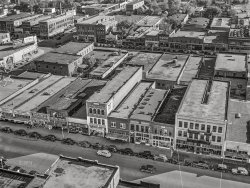
- Roast Beef: 1941
- ... of Chicago Blvd.
Delivery Truck The design of cars has changed a lot since 1941, but the design of the delivery truck is ... Posted by Dave - 06/21/2024 - 2:40pm -
![Roast Beef: 1941 June 1941. "Detroit, Michigan. Neighborhood where Charles A. Lindbergh was born." The For-Ham Pharmacy (and Dutch's Real Way Roast Beef) at the intersection of West Forest and Hamilton avenues. Photo by Arthur S. Siegel, Office of War Information. View full size.
Holy preservation, Batman!Googlers will find the intersection is little changed. (What?!?! In Detroit of all places?) I suspect the presence of nearby Wayne State is a major factor in keeping the neighborhood stable ... and yet still far enough away to avoid the expansion institutions inevitably undertake.
[The exact extent and nature of the preservation is curious: as shown on the street view (next post up) the corner building seems to be the same - tho remodeled and, perhaps , expanded - but the building next door is...not...quite...right. It's similar, but not the same (It's brick not stone, and the turrets and dormers aren't identical. Yet the Sanborn Maps shown the area unchanged up thru the 50's, and there don't seem to be any buildings nearby that it could be. Was it, too, remodeled; or moved there later? Hmmm]
[Your suspicions are correct. The drugstore address is 1100 West Forest, at the intersection with Hamilton Avenue, hence the name For-Ham. - Dave]
> Ah yes, that too. I've decided to leave the original post untouched: the preservation part doesn't work, sadly, but the Batman/Wayne tie-in does - the house ended as a Fraternity - but mostly it's a step-by-step on how elation faded into another 'Lost Detroit' story.
Now there's match! But the caption causes a bit of a problem : "View of the birthplace of aviator Charles A. Lindbergh in Detroit, Michigan, located at 1120 W. Forest." Which explains the description under the photo, but indicates it's the wrong intersection. Not Cass, but rather Hamilton...nine blocks west.( And the Sanborn Map confirms the location.) Just missed the John Lodge Freeway, but sadly, fate intervened anyway ... nothing in this pic remains today.
One-Way Streetcar Tracks"A Tip of the Hat" to Notcom for locating the correct intersection location. With that information and my copy of the 1949 Keystone Street Guide and Pocket Directory of Detroit I can identify the streetcar routes that used these tracks. Under Forest, W. 1100 Hamilton: Car-Hamilton-N. Under Hamilton 4700 Forest: Car-Crosstown-W. The delivery van is heading south on Hamilton. At this point the eastbound Crosstown streetcar was on nearby Warren Avenue, and the southbound Hamilton car was on Third Avenue. The John Lodge Freeway obliterated Hamilton south of Chicago Blvd.
Delivery TruckThe design of cars has changed a lot since 1941, but the design of the delivery truck is about the same as the one that just dropped off a package at my house.
$0.05Sorry Dave, but this oversize print is going to cost Shorpy 5 cents.
Power in the ShadowsSupplementing Angus J's streetcar information, the shadow tracks on the left (foreground to left-middle) were likely part of the Detroit Edison route.
[You mean the shadows of the overhead power supply? - Dave] Exactly!
(The Gallery, Arthur Siegel, Detroit Photos, Stores & Markets)](https://www.shorpy.com/files/images/SHORPY-8d45026u.thumbnail.jpg)
- A Lot of Cars: 1942
- ... the auto body plant was built til the time of the photo, cars had sure undergone a growth spurt.
Wonder how that lot made out in ... where you could see the Soap Box Derby winning cars on display in the lobby. Or the new models from the General Motors Five. ... Posted by Dave - 01/30/2023 - 1:30pm -
![A Lot of Cars: 1942 July 1942. "Detroit, Michigan. Looking down on a parking lot from the rear of the Fisher Building." Photo by Arthur Siegel for the Farm Security Administration. View full size.
Nowa Lot more!
All growed upInteresting to look at the size of the "slots" and the actual size of the vehicles parked in them. From when the auto body plant was built til the time of the photo, cars had sure undergone a growth spurt.
Wonder how that lot made out in the mid-fifties when automobile took a really big jump in size. Perhaps most of all in the creations coming from this very place.
[The Fisher Building is an office tower in downtown Detroit, not an auto body plant. - Dave]
I just thought it was a factory -- my mistake. Is the building named for the same person that ran the design and manufacturing company?
[Did you click on the link? The Fisher family financed the building with proceeds from the sale of Fisher Body to General Motors in the 1920s, after which it was known as the GM Fisher Body Division. - Dave]
Kid friendlyThe tunnel under West Grand Boulevard, from "The Golden Tower of the Fisher Building" to GM headquarters, where you could see the Soap Box Derby winning cars on display in the lobby. Or the new models from the General Motors Five.
Like so many other places in '50s Detroit: the Ford Rotunda, J.L. Hudson Co. downtown in December, the little trains at the Detroit Zoo, the Vernor's bottling plant at Woodward and Grand Boulevard, the model railroad layout in the basement of the Detroit Historical Society, the lobby of the Guardian Building, etc.
There was no admission charge for many of these adventures, which fit the family budget nicely. My father was a shrewd family time investor.
[Strictly speaking, the Ford Rotunda was in Dearborn. - Dave]
A lot of carsIs that what it's called? Like a
school of fish, or a
pride of lions, or a
murder of crows (my favorite).
(The Gallery, Arthur Siegel, Cars, Trucks, Buses, Detroit Photos)](https://www.shorpy.com/files/images/SHORPY-8c28556a.thumbnail.jpg)
- College of Cars
- ... are rolled down while the owners are away for the day?
Cars & Trucks The pickup next to the Corvette looks like a K series ... I also never knew that Korea had that many American cars back then. But this is definitely Korea - those rolling brownish-green ... Posted by tterrace - 06/24/2009 - 4:53pm -
![College of Cars Back in October 1956, my brother shot this Ektachrome slide to show the construction of the new Engineering Building at Cal Poly, and a student parking lot just happened to be in the foreground. Today it looks like a vintage car rally. For extra points: spot the Corvette. View full size.
Spotted the CorvetteIn the second row visible between the yellow pickup truck and black two door coupe.
Which Way Is It Going?Found it! Do I get an extra point for finding the Studebaker? (There's a light grey coupe above which is possibly another Stude.)
Steve Miller
Someplace near the crossroads of America
WindowsNotice how many of the driver's door windows are rolled down while the owners are away for the day?
Cars & TrucksThe pickup next to the Corvette looks like a K series International. The Stude is '48 or '49, the grey coupe above it looks Chrysler-ish to me, but there is a '42 or '46 Studebaker Champion across the road and there is a white sedan parked on the far side of the construction that might well be a '56. There's a sweet little Nash in the bottom left corner, you had to watch out for those you know!
Santa MariaI was fifth grader living in Santa Maria in 1956 (about 30 so miles south of SLO). The Vette looks so out of place in that assortment of vehicles. Had to be a prof's car, or a rich kid. Anyway, what really stood out for me was how many car windows are rolled down, and obviously unlocked. Bet you don't see that much these days in the Cal-Poly lots. What a wonderful era to be a kid. Safe, good economy, room to roam.
Also, there seems to be a tree growing out that huge dirt pile beyond the construction. Either that pile had been there way too long, or they just kind of piled up the dirt around it. I'm in construction, and odd stuff like that just jumps out at me. Just joking.
Spot the...Looks like I should have made it "Spot the Kaiser" instead.
Can you find a very nice yellow 54 Chevy Coupe?Hint - on the right side of the parking lot parallel parked.
ID this one...Can anyone ID the red car with the black soft top a few rows above the yellow pickup?
Two BuicksI also see at least two Buicks.
What's the model that's sixth from the left in the line of vehicles in which we're looking directly at their back bumpers? It has a vague boat-tail effect and a split rear window. Surely not a Tucker? Another Stude?
[1947ish Studebaker. - Dave]
Choppers!I also never knew that Korea had that many American cars back then. But this is definitely Korea - those rolling brownish-green hills, the cloudless blue sky.
Please keep in mind everything that I know about Korea I learned from watching M*A*S*H.
M*A*S*HMash was filmed in southern California not Korea. Read the caption.
[On the Totally Not Getting It scale of 1 to 10, you get an eleven! - Dave]
1984 Borgward Isabella1984 Borgward Isabella - Cal Poly had already invented a time machine
[Last year for the Isabella was 1962. Have a nice trip! - Dave]
Air QualityOf as much interest as the cars, to me, is the clarity of the air. That's how it used to be.
Kaiser spottingFirst find the Corvette to the right of the yellow pickup; next to that is an old (hah!) blue two-door coupe; right above that is the distinctive roofline and window configuration of a dark green post-1950 Kaiser.
I saw the purple car, too. That's a color you really didn't see factory-supplied those days, so it's got to be on someone's customized job.
Spot The Kaiser?Great photo! I just love to see this kind of picture, and always look for my '55 Olds, or my old '51 Kaiser Dragon. Is there really a Kaiser in this photo? I couldn't spot it! I did find a very purple car that I wish I could see more of! It is above the far Buick, in the outbuilding area. There is a dark red car there with its trunk open, too. It would be fun to see inside. Wish that dark panel truck was mine! Fabulous photo, with so many of the cars I still admire, all in one place and taken for granted! Kathleen
Other car-spottingYeah, the Corvette is interesting. Had to be a Rich Kid.
Equally interesting is the brand-new '56 Chevy (white, in the back near the center). Somebody had connections!
KaiserGood job, Tterrace! I wouldn't ever have caught that Kaiser, even with the same basic model sitting in my driveway for a decade or so! You are right, it's the windows that prove you right. And I will take this moment to mention that although I have been addicted to this site for a couple years now, it was your photos that really made me feel personal emotions, since we are from the same era. It is just great to see all the stuff from my childhood so well. Keep jumping the shark! P.S. I bet that purple car was someone's beloved hotrod!
Holy Frank Burns!I also noticed the BG hills look exactly as I remember from nearly every M*A*S*H episode. The cars in the lot are making me salivate; I was born 20 years too late (1964).
(ShorpyBlog, Member Gallery, Cars, Trucks, Buses, tterrapix)](https://www.shorpy.com/files/images/calpolycars_0.thumbnail.jpg)
- End of the Rainbow: Cars!
- ... San Luis Obispo, seems to end on a row of classic 50s cars. The two-tone '53 Olds is nice, but I wish it wasn't obscuring the ... later and still no available parking on campus!
Big Cars on Campus Not everyone on campus had the latest cars. There's a '48 ... Posted by tterrace - 06/24/2009 - 5:10pm -
